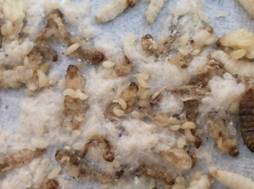Bio control:: Mass production::Parasitoids
| Mass production of Bracon brevicornis |
|
- B. brrvicornis is an important gregarious larval ecto-parasitoid of many lepidopterans.
- It is widely distributed and recorded from Antigastra catalaunalis, Adisura atkinsoni, Earias sp., Helicoverpa armigera,Noorda moringae, Opisina arenosella, Pectinophora gossypiella, Chilo partellus etc.,
- Its natural parasitism is not very high.
- However, it paralyses many lepidopteran larvae and some of them never revive. This contributes to indirect control.
|
Production procedure
- B. brevicornis is amenable for mass rearing in the laboratory on the alternate host, Corcyra cephalonica. For small scale culture, glass chimney and the ‘Sandwich’ technique are adequate.
- About 20 mated females are confined in a glass chimney, covering both sides of the chimney with muslin sheet held in place with rubber bands.
- A cotton swab soaked in 50% honey water solution is stuck to the side of the chimney to serve as food. With many hymenoptera, adult nutrition is of great importance as it influences sex-ratio.
- High protein diet at times improves the sex ratio so that more female progeny are produced. ‘Proteinex’ can be used to produce the desired results.
- Replacing honey with laevulose or fructose also is beneficial in some cases. Exposure to sunlight frequently stimulates mating, oogenesis and fertilization of eggs.
- About 10 full grown larvae of Corcyra are placed between two sheets of facial tissue paper and placed over the muslin sheet covering the wider mouth of the chimney.
- The tissue is again covered with a sheet of muslin and fastened with a pair of rubber bands.
- The chimney is then placed with the host larvae facing a window or light source. Females of B. brevicornis are attracted to the host larvae, probe through the muslin and paralyze the larvae on each of which they lay about 25 eggs per day.
- At the end of 24 hours, the tissue sheets bearing parasitized larvae are removed and held in flat plastic containers until the parasitoid grubs hatch, complete development and spin cocoons.
- The egg, larval pupal and adult stages are completed in 28-36 hours, 4-7, 3-6 and 15-40 days respectively.
- The female parasitoid is capable of depositing 150-200 eggs in its life time. Emerging adults are again collected for mating and egg laying.
- Adults survive up to 15-40 days but egg laying usually tapers off after the first ten days. Two day old adults of B. brevicorniscould be stored for 30 days at 50C and 50-60% RH.
|

Bracon brevicornis |
|
|

